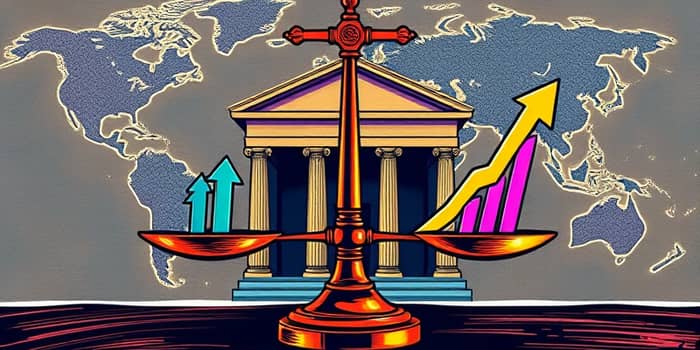
As the world emerges from the tumultuous economic aftermath of the COVID-19 pandemic, one persistent challenge remains at the forefront of policymakers’ minds: inflation. After surging to nearly 9% in late 2022, global consumer price indices have since retreated but still linger above the comfortable levels seen in the 2010s. Central banks find themselves walking a tightrope between curbing rising prices and sustaining fragile recoveries.
Although headline rates have approximately halved to below 5% by late 2024, this decline masks significant volatility across regions. Projections for 2025 place global inflation around 4.3%, according to the IMF, and slightly lower forecasts hint at a plateauing of downward momentum. In this context, central banks’ capacity to maintain price stability is under intense scrutiny.
With advanced economies projected to average 2.5% inflation and emerging markets at roughly 5.5%, the variance in price pressures presents unique policy dilemmas. In countries like Argentina, where rates top 47%, and Angola at over 22%, the stakes are elevated. The struggle to anchor expectations highlights deeper structural challenges in an era of supply disruptions, energy transitions, and shifting labor markets.
From the height of pandemic-induced supply chain bottlenecks to post-lockdown demand spikes, inflationary pressures spread rapidly across the globe. Food and energy prices, which initially drove much of the increase, have shown signs of softening but remain sensitive to geopolitical tensions and commodity market swings.
Policy responses, including aggressive rate hikes and large-scale fiscal support, contributed to slowing price growth. Nonetheless, the interplay of tight labor markets and wage growth continues to underpin persistent price pressures. As central banks tighten monetary policy, they face the difficult task of balancing growth objectives against the imperative to tame inflation.
Despite a general moderation in headline inflation, specific regions continue to experience extreme price volatility. In Argentina, rates exceed 47% as currency weakness and policy uncertainty drive runaway price increases. Similarly, Angola’s economy contends with double-digit inflation fueled by fiscal deficits and currency pressures. These outlier cases underscore the widening gap between advanced and developing economies in managing inflationary shocks.
For emerging economies, structural vulnerabilities such as limited central bank independence, volatile capital flows, and weaker institutional frameworks can exacerbate price swings. Meanwhile, in advanced markets like the United States and the Eurozone, inflation has settled closer to target ranges but remains susceptible to cyclical shocks, including energy price reversals and supply chain disruptions.
Several interconnected factors contribute to ongoing price pressures worldwide. First, rising wage pressures amid labor shortages have persisted in sectors ranging from manufacturing to services. Elevated wages can feed through to consumer prices unless productivity gains offset higher labor costs.
Second, trade protectionism and increased fiscal spending have added upward pressure, as import tariffs and expansive budgetary measures amplify input costs and demand. Finally, the green energy transition and commodity market shifts influence energy prices: while investments in renewables gradually lower some costs, supply constraints for critical materials and infrastructure bottlenecks can drive up others.
In response to stubborn inflation, central banks have embarked on an era of aggressive monetary tightening. The Federal Reserve, European Central Bank, and others have raised policy rates multiple times since 2021, signaling a commitment to price stability. Yet, this approach carries the risk of over-tightening, potentially tipping economies into recession.
These measures test the limits of central bank credibility. If consumers and businesses believe that price stability is not assured, inflation expectations may become unanchored, leading to a self-fulfilling spiral. Maintaining trust requires a clear track record of achievement and consistent policy signaling under adversity.
As inflation dynamics grow more complex, central banks are turning to artificial intelligence and machine learning for deeper insights. Advanced models can rapidly disaggregate inflation drivers, identify emerging trends, and stress-test scenarios under varied assumptions. This capability is particularly valuable in volatile environments where traditional forecasting methods may lag.
By leveraging real-time data analysis and predictive modeling, policymakers can respond more nimbly to shocks, whether from commodity price swings or shifting consumer preferences. In developing economies with limited analytical resources, AI tools offer a path to enhancing forecasting accuracy and policy design, thereby strengthening institutional resilience against persistent inflation pressures.
Looking forward, the inflation outlook hinges on a delicate balance of forces. Price pressures may ease as supply chains normalize and fiscal stimulus recedes, but risks remain from geopolitical tensions, renewed commodity price spikes, and policy missteps. Central banks must navigate a landscape in which inflation expectations are fragile and economic growth uneven.
For emerging and developing economies, the challenge is even more acute. Limited fiscal space and volatile capital flows can force tough trade-offs between supporting growth and maintaining price stability. Strengthening monetary institutions, investing in data infrastructure, and safeguarding central bank independence will be crucial steps in bolstering resilience.
Ultimately, the era of post-pandemic inflation has tested the mettle of central banks worldwide. Anchoring public expectations, deploying innovative analytical tools, and crafting balanced policies will define success in the years ahead. While the road to stable prices and sustainable growth is fraught with uncertainty, a commitment to credible, transparent, and data-driven policy offers the best path forward in an unpredictable global economy.
References













